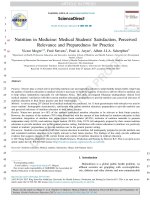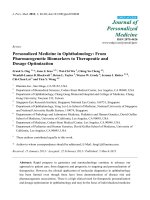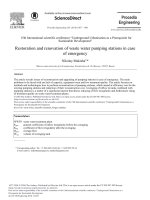Pediatric emergency medicine trisk 3162 3162
Bạn đang xem bản rút gọn của tài liệu. Xem và tải ngay bản đầy đủ của tài liệu tại đây (99.02 KB, 1 trang )
been used successfully for severe bradycardia. Blood pressure support is rarely
necessary.
Inhalants
Current Evidence
The prevalence of inhalant abuse among young children and adolescents is
related to their ready availability. Patterns of abuse are also strikingly region
specific, with the highest rates of abuse in the southwestern and southeastern
United States. Typically, the agents are abused by “huffing” or “bagging.” In
huffing, the agent is placed into a rag or handkerchief, held under the nose, and
then deeply inhaled. With bagging, a common method of abuse at parties, the
compound is placed into a large bag (e.g., garbage bag) with the drug user placing
his or her head into the bag.
The psychoactive inhalants can be placed into three broad categories: (i)
hydrocarbons, (ii) nitrous oxide, and (iii) nitrites. The hydrocarbons can be
subdivided further into the aliphatic hydrocarbons, the halogenated hydrocarbons,
and solvents. Regardless of the class, all inhalants possess the pharmacologic
property of narcosis, leading to euphoria and light-headedness after inhalation.
The halogenated hydrocarbons are particularly dangerous because they sensitize
the myocardium to catecholamines, potentially leading to myocardial irritability
and cardiac dysrhythmias.
Clinical Considerations
Several distinct profiles of inhalant abuse toxicity have been described.
Inebriation may be associated with mental status changes that include coma with
respiratory arrest or aspiration. The halogenated hydrocarbons all possess potent
cardiotoxicity, as noted above, and have been associated with reports of
spontaneous ventricular fibrillation in adolescents. A syndrome known as sudden
sniffing death has been described in adolescents who abuse inhalants and is most
commonly reported with use of halogenated hydrocarbons. Finally, the act of
bagging is associated with the risk of simple asphyxia. Finally, acute exposure to
inhalants containing nitrites may lead to severe methemoglobinemia.
Other toxicities are associated with chronic inhalant abuse. The solvents,
particularly toluene, may lead to a syndrome that includes abdominal pain,
muscle wasting, electrolyte disturbances (hypokalemia), and renal tubular
acidosis. Patients of chronic solvent abuse may also develop a
leukoencephalomalacia with cerebral atrophy.









